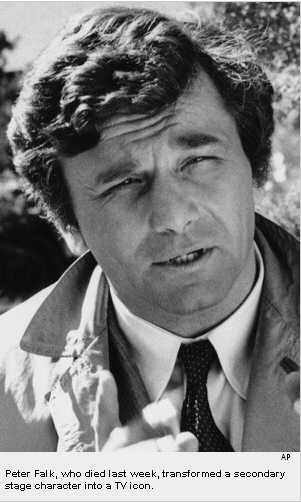|
||||||||
 Everybody
knows Columbo from television. Everybody
knows Columbo from television.But in fact, the beloved disheveled detective made his first appearance in a stage play called "Prescription: Murder," by the now-legendary writing team of Richard Levinson and William Link. The play debuted in San Francisco in 1962. Joseph Cotten played a slick psychiatrist who concocts a clever scheme to murder his wife. Thomas Mitchell, a popular Hollywood character actor of the day, played Lieutenant Columbo. Columbo was a secondary role, but as Mark Dawidziak points out in his excellent book "The Columbo Phile," audiences loved him.  "When
Thomas Mitchell took his curtain call, the applause would go through
the roof," Levinson, who died in 1987, told Dawidziak. "When
Thomas Mitchell took his curtain call, the applause would go through
the roof," Levinson, who died in 1987, told Dawidziak."Prescription: Murder" never made it to Broadway, but it was successful enough on tour that Levinson and Link decided to adapt it for television in 1968. Mitchell had died, so the writers had to find a new Columbo. Lee J. Cobb, the original Willy Loman in "Death of a Salesman," was on their list. So, too, was Bing Crosby, although at this point he preferred golfing to working. And then Link got a phone call. "I remember it so well," Link told me this week. "It was Peter Falk, and he said: 'Hey, I just read that terrific script of yours, and I'll kill to play that cop.' Well, he got to play that cop, and the rest is history." Falk, who died last week at 83, will forever be identified with Columbo, a role for which he won four Emmys. "What Peter brought to the character was likability," says Link. "I always said he was Holmes and Watson in the role. He had the brilliance of Holmes but the everyday quality of Watson. And he was endearing. To know him was to love him. We wrote a good role, and Peter made it a great one." Falk was completely invested in the character. The famous raincoat, in fact, belonged to the actor. Caught in a sudden rainstorm one afternoon on West 57th Street, he dashed into a clothing store and bought it. "The wardrobe department made three backup raincoats, but he always wore the original," says Link. "The Smithsonian wanted it, but he wouldn't let them have it. He kept it in an upstairs closet. He used to say, 'Every night, I put a bowl of milk out for it.' " Falk, who starred on Broadway in Neil Simon's "The Prisoner of Second Avenue," was a brilliant but temperamental actor. The "Columbo" series was an immediate hit for NBC and Universal Studios, and Falk quickly exercised his power. He held out for more money, eventually earning $500,000 an episode, which made him the highest paid actor in the world at the time. And he wanted to direct. "Lew Wasserman, who was then the president of MCA Universal, said no way," Link recalls. "So Peter got ill and took to his bed. Finally, he had lunch with Herb Schlosser, the president of NBC. He said, 'I got this steel band around my forehead, Herb. I can't act. I just can't do it. You understand, Herb.' Well, he brought Lew Wasserman to his knees and got everything he wanted." Levinson and Link got their revenge, however. "We gave him the worst script to direct," says Link. Titled "Blueprint for Murder," it was about an architect who murders a real estate tycoon. Filming took place on the actual construction site of the Century City Complex in Los Angeles. "Every day, Dick and I would take a limo from Universal to watch Peter trying to direct in this construction pit. He was coughing and spitting, and we'd say, 'Hey, Peter, how's it going?' He'd shake his fist and shout, 'You bastards.' But he never wanted to direct again." Levinson and Link used black humor to lighten the atmosphere when their star became too demanding. Falk famously had a glass eye, having lost his real one as a boy because of a tumor. When people would ask Levinson and Link which was the glass eye, they'd say: "The one with a gleam of intelligence." Despite the battles and Falk's bouts of "malingering," as Link calls it, when he wanted more money, Levinson and Link always "left Peter as friends," Link says. "He was a big star who cared deeply about the character and the scripts, and that was great for us and for the viewers. We loved him. It's a great loss. But, as we always say, we have the film . . . " michael.riedel@nypost.com Copyright 2011 New York Post Visit their website at www.nypost.com |
||||||||
|
|
||||||||
| Website copyright 2011 by William Link. Photo of William Link and Peter Falk by Douglas Kirkland Book cover illustration by Al Hirschfeld. Copyright Al Hirschfeld. Hirschfeld exclusive representative is Margo Feiden Galleries, Ltd., New York Website by Dovetail Studio. |
||||||||
